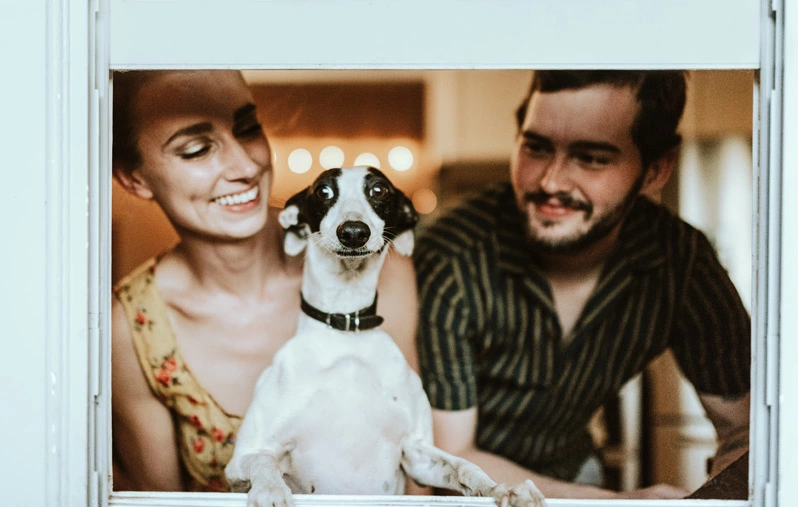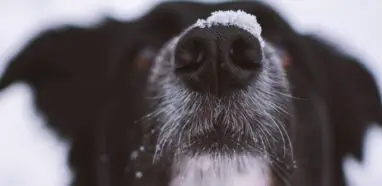Do dogs have knees or elbows? Canine anatomy can easily leave you consumed, often because it is just too complicated. Many people are sure that dogs have hind and front legs but they are not so sure on whether they also have knees and elbows.
Read on to know the answer to this mystifying question.

Table of Contents
Does your dog have knees

Yes, dogs do have knees. In fact, they play an important role when it comes to making it possible for dogs to walk, jump, and run. Canines have two knees, with one on each of the two hind legs. Health risks in canines that are related to their knees include:
- Knee arthritis
- Ligament injuries
- Luxating patella
The anatomy of the leg of dogs can easily become quite complex. In simple terms, a dog’s knee or also known the stifle joint consists of three bones:
These three bones are all connected to form the knee of a dog.
How many knees do dogs have
Those who are not that familiar with the anatomy of dogs might have no idea how many knees dogs have. As mentioned earlier, a dog has two knees and both of these can be found on the back or hind legs.
Do dogs also have knees in the front legs
There are some people who have this mistaken belief that dogs actually have four knees, with two on their back legs and two more on their front legs. Well, the truth is that there are two elbows on the front legs of a dog while the two legs at the back have two knees.
How do the knees of a dog function
Once you get into the part of how the anatomy of a dog functions, it is exactly where things can get a little bit more complicated.
Even though bones are crucial parts of a dog’s knee, the cartilage, muscles, and ligaments also do lots of heavy lifting as far as knee function is concerned.
The patellar ligament is the primary ligament in the knee of a dog. This particular ligament is holding together all of the knee bones and preventing them from going out of proper alignment.
The cartilage is the one covering the bones’ ends and serves as a cushion allow movements without pain or grinding. The muscles that surround the knee offer the necessary power for moving the ligaments and joints.
Do dogs suffer from knee problems
Yes, they do. Since there are several moving parts that make up the knee of your dog, it is only natural that there are also plenty of things that could go wrong. The most common knee-related problems that a dog may suffer from include:
- Cranial cruciate ligament rupture
- Patellar luxation
- Knee arthritis
Cranial cruciate ligament rupture in dogs
Cranial cruciate ligament rupture is one of the most usual knee issues that dogs suffer from. This condition is when the ligament stabilizing the knee ruptures. If you ever see a dog that cannot use his hind legs properly, it is likely that he is suffering from this condition.
Which dog breeds are affected by cranial cruciate ligament rupture
CCL or cranial cruciate ligament rupture is a rather common knee issue in all dog breeds but this condition often occurs in certain breeds including:
- Labrador Retrievers
- Golden Retrievers
- Pit Bulls
- Rottweilers
Take note that this list is not complete.
What causes cruciate ligament rupture?
A dog may end up rupturing his CCL in any of two main ways and these could be over time or all of a sudden. Sudden ruptures may be due to physical injuries such as twisting the ligament during a run or a fall.
There are also times when the ligament may tear over time and since the tear occurs over time, pinpointing the specific activities that caused the rupture might not be easy.
Signs of cranial cruciate ligament rupture in dogs
There are actually several telltale signs that may indicate that a dog suffers from this condition. These include the following:
- If the injury is only mild and not that severe, it is possible that you will notice your pup avoiding the use of the affected knee at specific times.
- Your pooch might stop the use of the affected knee right away.
- Your pup might cry out in pain.
If your pet shows any of these signs, whether a fall occurred or not, make sure that you take him to the vet and have him undergo a knee exam.
The vet will be able to tell immediately if your dog is suffering from a ruptured CCL. There might also be a need for an X-ray to get a much clearer picture of the condition of your pet’s knee.
CCL rupture treatment
CCL rupture is never something that you can just leave to heal on its own because most of the time, the ligament cannot move by itself.
But, your vet might be able to treat your pet with no need for a surgery. Some of the best forms of non-surgical treatment options include:
- Controlled exercises
- Rest
- Medication for inflammation control
However, there are still some instances when surgery is required for repairing the ligament. When this happens, a vet surgeon will manually restore the stability of the knee joint. Your dog may have a hard time to heal following the surgery. Restorative surgery is not cheap so non-surgical treatment options are often more preferred than surgery.
Patellar luxation in dogs
Patellar luxation may sound unfamiliar to you but a lot of dogs are actually suffering from this condition. This disease is where the patella bone, one of the knee’s most prominent bones, gets dislocated.
Medical experts have categorized the condition into four stages:
- Stage 1 is considered as the mildest form in which there is only a small degree of dislocation in the patella.
- The dislocation’s severity increases in stage 2 and stage 3.
- The dislocation becomes so bad in stage 4 that repairing it becomes difficult.
Patellar luxation usually becomes apparent when your dog is already a few months of age. Observant owners might realize that their pup will not let one of their hind paws to have any contact with the ground. There might also be a certain level of awkwardness in the running stance of your pup.
Which dog breeds are affected by patellar luxation
The following dog breeds are most prone to developing patellar luxation:
- Bedlington Terriers
- Boykin Spaniels
- Chow Chows
- Pomeranian
- Yorkshire Terriers
If you will notice, it is a condition commonly seen in smaller dogs. But, this condition may also develop in some larger dogs. Take not that the list of dogs that suffer from this condition is not an exhaustive one.
What causes patellar luxation?
Patellar luxation is a type of genetic condition. This means that if one of the parents of your pup had this condition, it increases the odds that your dog will also develop it.
There are no hard and fast preventive measures you can take to prevent this condition. However, there are some vet who suggest that you do a few things to avoid putting stress on the knees of your dog. You can install a ramp or doggy steps in your house or you can also carry your pup up high steps or ever time they need to jump on their own, such as onto the bed, onto the couch, or into the car.
Patellar luxation treatment
Surgery is the primary treatment for patellar luxation. It is specifically true for those severe cases of dislocated patella.
But, if your pet is just mildly affected, the only thing you can do is to make certain accommodations to make your pet more comfortable.
If ever you suspect that your pet suffers from patellar luxation, it is best to visit the vet right away. If take your pet to a professional sooner, he will also be able to receive proper treatment sooner that will help restore his quality of life.
Knee arthritis in dogs
After knowing about the two most unbearable knee conditions that dogs may suffer from, it is time to learn about arthritis.
Canine arthritis can be best described as the stiffness in the knee joint of a dog.
The joint gets inflamed once the cartilage found in the middle of the knee bones starts wearing away. Your dog will be more at risk of suffering from this condition as he gets older and it often worsens over time in general.
Ligament damage due to the two conditions above is the main cause of canine arthritis. Pain, reduction in movement, and irritability are the most obvious and common signs of arthritis in canines.
Never waste time when you suspect that your pup has arthritis. Take him to the vet right away to get started with the treatment immediately.

The unique literary talents of Dr. A. Barton are well known throughout the veterinary profession. He is a regular contributor to the New York City Veterinarian and his professional articles have also appeared in the Journal of the American Veterinary Medical Association, Journal of Small Animal Medicine, Veterinary Medicine, Cornell Veterinarian and Philadelphia Medicine. He is the only veterinarian ever to have had an article published in the human medical publication, What’s New.



